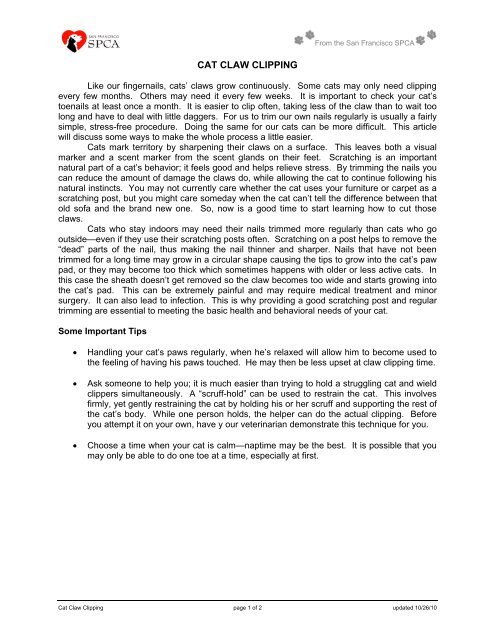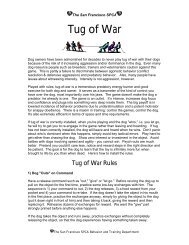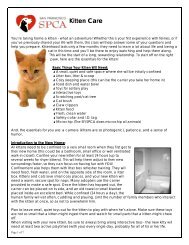Cat Claw Clipping - San Francisco SPCA
Cat Claw Clipping - San Francisco SPCA
Cat Claw Clipping - San Francisco SPCA
Create successful ePaper yourself
Turn your PDF publications into a flip-book with our unique Google optimized e-Paper software.
From the <strong>San</strong> <strong>Francisco</strong> <strong>SPCA</strong><br />
CAT CLAW CLIPPING<br />
Like our fingernails, cats’ claws grow continuously. Some cats may only need clipping<br />
every few months. Others may need it every few weeks. It is important to check your cat’s<br />
toenails at least once a month. It is easier to clip often, taking less of the claw than to wait too<br />
long and have to deal with little daggers. For us to trim our own nails regularly is usually a fairly<br />
simple, stress-free procedure. Doing the same for our cats can be more difficult. This article<br />
will discuss some ways to make the whole process a little easier.<br />
<strong>Cat</strong>s mark territory by sharpening their claws on a surface. This leaves both a visual<br />
marker and a scent marker from the scent glands on their feet. Scratching is an important<br />
natural part of a cat’s behavior; it feels good and helps relieve stress. By trimming the nails you<br />
can reduce the amount of damage the claws do, while allowing the cat to continue following his<br />
natural instincts. You may not currently care whether the cat uses your furniture or carpet as a<br />
scratching post, but you might care someday when the cat can’t tell the difference between that<br />
old sofa and the brand new one. So, now is a good time to start learning how to cut those<br />
claws.<br />
<strong>Cat</strong>s who stay indoors may need their nails trimmed more regularly than cats who go<br />
outside—even if they use their scratching posts often. Scratching on a post helps to remove the<br />
“dead” parts of the nail, thus making the nail thinner and sharper. Nails that have not been<br />
trimmed for a long time may grow in a circular shape causing the tips to grow into the cat’s paw<br />
pad, or they may become too thick which sometimes happens with older or less active cats. In<br />
this case the sheath doesn’t get removed so the claw becomes too wide and starts growing into<br />
the cat’s pad. This can be extremely painful and may require medical treatment and minor<br />
surgery. It can also lead to infection. This is why providing a good scratching post and regular<br />
trimming are essential to meeting the basic health and behavioral needs of your cat.<br />
Some Important Tips<br />
<br />
<br />
<br />
Handling your cat’s paws regularly, when he’s relaxed will allow him to become used to<br />
the feeling of having his paws touched. He may then be less upset at claw clipping time.<br />
Ask someone to help you; it is much easier than trying to hold a struggling cat and wield<br />
clippers simultaneously. A “scruff-hold” can be used to restrain the cat. This involves<br />
firmly, yet gently restraining the cat by holding his or her scruff and supporting the rest of<br />
the cat’s body. While one person holds, the helper can do the actual clipping. Before<br />
you attempt it on your own, have y our veterinarian demonstrate this technique for you.<br />
Choose a time when your cat is calm—naptime may be the best. It is possible that you<br />
may only be able to do one toe at a time, especially at first.<br />
<strong>Cat</strong> <strong>Claw</strong> <strong>Clipping</strong> page 1 of 2 updated 10/26/10
From the <strong>San</strong> <strong>Francisco</strong> <strong>SPCA</strong><br />
How To Do It<br />
<br />
<br />
<br />
Check the cat’s paws for dirt; although they usually keep their own feet clean, you will<br />
want to be able to see the claw clearly. You can extend the cat’s nail by picking up the<br />
cat’s foot and gently applying a little pressure on the top and bottom of the toe just<br />
behind the nail.<br />
Make sure there is enough light. Having the cat’s paw between the source of light and<br />
yourself makes it much easier to see where you need to cut.<br />
Keep the clippers perpendicular to the nail. Look for the “quick” in the cat’s nail. Notice<br />
how far into the nail the quick extends. (The quick is a vein. You can see it as the<br />
pinkish area inside the nail.) The clipper is best placed about 1/8 inch forward of the<br />
quick. If you cat will sit still long enough, you may want to gently file the tips after<br />
cleaning.<br />
CAT’S CLAW<br />
Quick<br />
Cut Here<br />
If You Trim The Nail Too Close<br />
Your cat may give a cry and try to pull away from you. You may observe a small bit of<br />
blood on the end of the nail. Wipe the blood away with a tissue or paper towel. Dab some<br />
super glue or styptic powder on the tip to stop the bleeding. You can find these products at the<br />
drug store or at a pet shop. In the future, you will want to cut the nails a little further away from<br />
the quick.<br />
<strong>Cat</strong> <strong>Claw</strong> Clinic<br />
We also offer a <strong>Cat</strong> <strong>Claw</strong> <strong>Clipping</strong> Clinic for guardians who need regular assistance<br />
keeping kitty’s claws clipped. For questions and more information, please call 415-554-3030 or<br />
email hospital@sfspca.org<br />
For more information about cat behavior please visit www.sfspca.org .<br />
<strong>Cat</strong> <strong>Claw</strong> <strong>Clipping</strong> page 2 of 2 updated 10/26/10
















